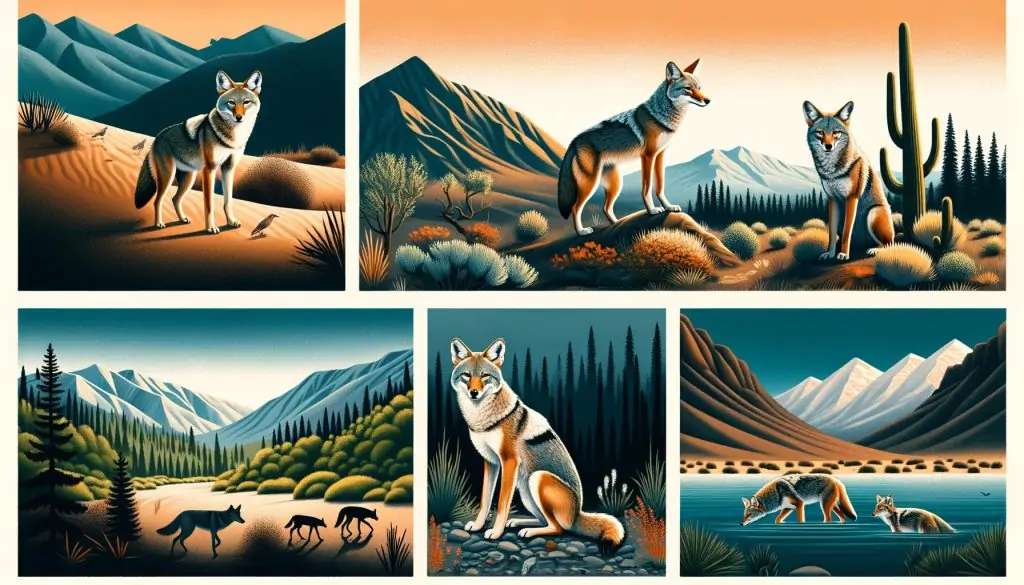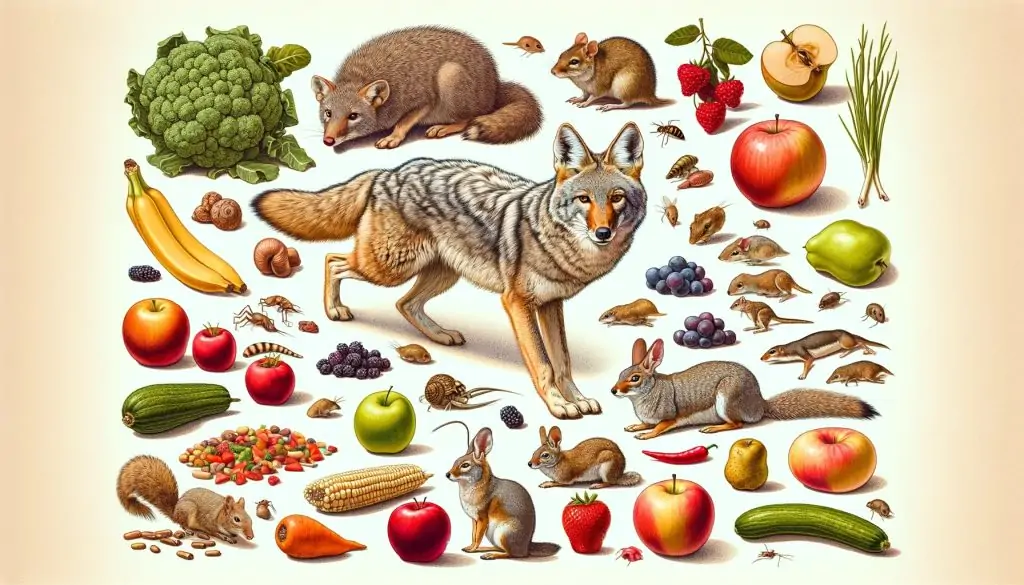We hope you love the products we recommend and just so you know that as an Amazon Associate CoyoteHunting.org may earn from qualifying purchases.
Key Takeaways: Predators of Coyotes
The information in the following table provides a comprehensive overview of the various animals known to hunt and kill coyotes according to our research:
| Predator Type | Examples of Animals that Kill Coyotes |
| Mammalian Predators | Wolves, Grizzly Bears, Black Bears, American Black Bears, Cougars, Canada Lynxes, Other Coyotes, Mountain Lions |
| Avian Predators | Golden Eagles, Bald Eagles, Great Horned Owls |
| Reptilian Predators | American Alligators |
| Domestic and Farm Animals | Dogs (in certain situations), Donkeys (used as guard animals by ranchers) |
| Human Impact | Humans (including impacts from hunting and vehicle collisions) |
This table encompasses the diverse array of predators that coyotes encounter, highlighting the ecological challenges they face across different regions, including Alaska. It brinks a new meaning to the phrase ‘you gotta watch your back!’
Table of Contents
Understanding Coyote Behavior and Habitat

As someone deeply fascinated by the natural world, I’ve always been intrigued by the behaviors and habitats of various animals, particularly coyotes and their pups.
These creatures, often misunderstood and misrepresented, have a complex and intriguing lifestyle that deserves our attention.
Coyotes, known scientifically as Canis latrans, are highly adaptable animals found primarily across North America. They have a remarkable ability to thrive in diverse environments, from the arid deserts of the Southwest to the dense forests of the Northeast, and even in urban settings.
This adaptability stems from their omnivorous diet and opportunistic hunting style, making them one of the most versatile predators on the continent.
Behaviorally, coyotes are known for their cunning and resourcefulness. In the wild, their social structure can be quite fluid.
While they are often seen alone or in pairs, they can also form larger packs, especially when hunting larger prey or defending their territory.
Coyotes are primarily nocturnal but can be active during the day, particularly in areas with less human activity.
Their habitats are as varied as their diets. Coyotes prefer open spaces where they can easily hunt and scavenge for food, but they are also comfortable in forested areas and mountainous terrains.
The key to their survival in these habitats is their incredible adaptability, which allows them to adjust their hunting and denning behaviors to suit their current environment.
The Coyote’s Diet: A Glimpse into What Coyotes Eat

I’ve always been fascinated by the diets of different animals, and coyotes are no exception. What a coyote eats is a testament to its adaptability and survival skills in various environments.
Let me take you through what coyotes hunt and eat, showcasing their versatile feeding habits.
Coyotes are primarily carnivores, but they have an omnivorous diet, which means they eat both meat and vegetation. A significant portion of what coyotes eat consists of small mammals like rodents, rabbits, and squirrels.
These small prey are crucial for their sustenance, especially in rural and wilderness areas. However, coyotes are not picky eaters. Their diet can also include fruits, vegetables, and insects, particularly when their usual prey is scarce.
In urban areas, coyotes have adapted to scavenging.
They are known to rummage through garbage bins and even prey on small domestic animals when the opportunity arises. This adaptability in their diet is one of the reasons why coyotes have thrived even in environments heavily modified by humans.
Coyotes also play a significant role in controlling the population of pests and rodents. By preying on these animals, they help maintain a balance in the ecosystem.
This aspect of the coyote’s diet is beneficial to farmers and gardeners, as it keeps the populations of potentially harmful pests in check.
Their opportunistic and varied diet reflects the coyote’s ability to adapt and survive in different habitats, from the wild plains to urban landscapes. As we explore the world of coyotes, their diet offers us a glimpse into their lives and their crucial role in the ecosystem.
Now that we have discussed what coyotes eat, lets talk about what animals kill and often eat coyotes.
Natural Threats: Major Predators of Coyotes
Wolves: Dominant Canine Rivals
Wolves are one of the major predators of coyotes. Known for their pack hunting strategies, wolves compete with coyotes for food and territory. They have been documented preying on coyotes, particularly in colder months or when food is scarce.
Eagles: Predators from Above
Golden eagle and bald eagles target young or weaker coyotes, showcasing the aerial dangers these canines face. Their hunting prowess from the skies is a constant threat to coyotes.
Cougars and Lynxes: Feline Coyote Predators
As stealthy hunters, cougars and Canada lynxes are formidable coyote predators. Their ability to ambush predators like coyote underscores the diverse threats in their natural habitats.
American Alligators: The Reptilian Danger
In wetland areas, American alligators can be lethal, and known to attack coyotes, illustrating the varied and unexpected dangers they face across different ecosystems.
Grizzly Bears & Black Bears: The Omnivorous Threat
Both grizzly bears and black bears, due to their omnivorous nature, can occasionally prey on coyotes, adding another dimension to the predator-prey dynamics in the wild.
Donkeys: The Unlikely Guardian Animals
Interestingly, donkeys, often used as guard animals on farms, can pose a threat to coyotes. Their protective nature and aggression towards intruders like coyotes make them effective at deterring these canines.
Mountain Lions: Stealthy Predators
The mountain lion, known for their stealth, pose a significant threat to coyotes. Excelling in ambush tactics, these large felines often compete with coyotes for food and territory, showcasing the harsh realities of the wild.
Intra-Species Conflict: Coyote vs. Coyote Hunt
Conflicts within their own species also pose a threat to coyotes, especially over territorial disputes or competition for resources.
The world of coyotes is fraught with natural predators, each representing a unique challenge to their survival. Understanding these natural threats is key to appreciating the complex ecological role coyotes play.
Human Impact and the Coyote Population
Coyote Encounters with Human Expansion
The expansion of human territories has had a significant impact on the coyote population.
As we have encroached upon their natural habitats, coyotes have shown remarkable adaptability, learning to navigate and survive in urban and suburban landscapes. However, this interaction with human environments is not without its challenges.
Conflicts and Management Strategies
Coyotes often find themselves in conflict with humans, primarily due to their reputation as pests, especially in rural areas where they are known to prey on livestock.
In response, and in a conservation effort, various management strategies and regulations in each state have been employed to control their population. Often by the various departments of hunting and fishing.
These strategies include trapping, hunting, and in some cases, the use of deterrents to keep them away from human habitats. Much like hunting deer or going to fish, there are different rules that apply depending on your location.
Roadway Hazards for Coyotes
Another significant human impact on coyotes comes from vehicle collisions. Busy roads and highways that cut through their habitats pose a considerable risk to coyotes, often leading to fatal encounters. This has become an increasingly common threat to their population, particularly in areas where their natural habitat intersects with developed regions.
Adaptation to Urban Environments
Despite these challenges, coyotes have shown an incredible capacity to adapt to urban environments. They have learned to scavenge and hunt in these new settings, sometimes even changing their nocturnal habits to avoid human interaction. This adaptability of coyotes is a testament to their resilience and ability to survive in changing landscapes.
Conclusion: Balancing the Ecosystem with Coyote Predation
In this exploration of “what animals hunt coyotes,” we’ve uncovered the intricate web of predator-prey dynamics that define the coyote’s existence. The coyote, a resilient and adaptable species, faces various natural threats from wolves, eagles, cougars, lynxes, bears, alligators, and even members of its own species. These interactions highlight the coyote’s role in the ecological balance, where it stands as both hunter and hunted.
Human impact on coyotes has been profound, ranging from habitat encroachment to conflict management. Despite these challenges, coyotes have shown remarkable adaptability, thriving in both rural and urban environments. However, this coexistence with humans brings its own set of challenges, emphasizing the need for informed and responsible wildlife management.
This article has shed light on the diverse range of animals that hunt coyotes, offering a glimpse into the complex relationships within ecosystems. Understanding these dynamics is crucial for appreciating the delicate balance of nature and the role each species, including coyotes, plays in maintaining it.
References
- “Coyote” – Wikipedia, The Free Encyclopedia, https://en.wikipedia.org/wiki/Coyote
- “Predator and Prey: A Guide to the Coyote’s Natural Enemies” – National Wildlife Federation, https://www.nwf.org
